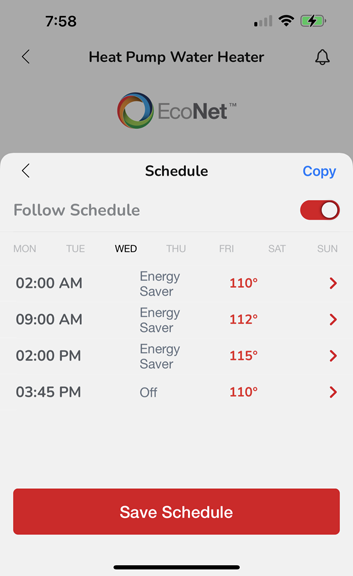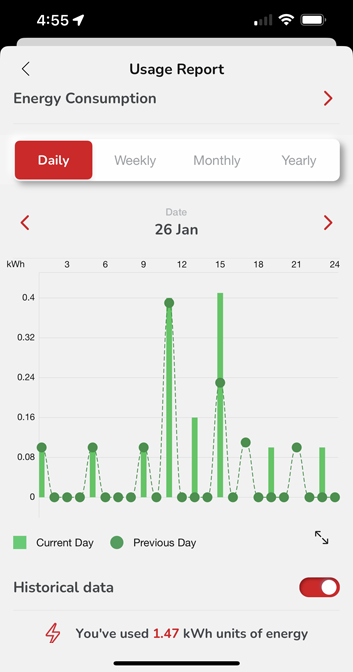Setting up a Rheem Heat Pump Water Heater, Part 3
My Experiment to Compare the Power Consumption of Heat Pump Mode Versus Energy Saver Mode
Over the last eleven days I ran a series of experiments which limited the number of variables to two: heat pump modes and water usage levels. Rheem insists that their Energy Saver mode is more efficient than their Heat Pump mode, despite the plain fact that their current heat pumps are generally about four times more efficient overall than conventional resistance heating elements. Heat Pump mode is described as utilizing only the heat pump of the hybrid water heater and Energy Saver is described as using both the heat pump and resistance heating. A telephone support person gave me the further clue that only the upper of the two heating elements is used in Energy Saver mode, but I've never seen any other confirmation of that. It makes sense though that this would be true.
Heat pump efficiency varies considerably with the temperature of the air entering the heat pump from which heat is taken. The official lower limit for heat pump operation of our Rheem PROPH40 T2 RH375 nominally 40 gallon model is stated as 35° F, if memory serves. Our daily high temperatures over this 11-day period ranged from 48° to 68° F, with the daily lows being between about 36° and 50° F. I was able to tightly control the hot water usage variable by using zero hot water on eight of the eleven days, and close to 12 gallons on each of the other three. The data clearly show that the ambient temperature had an effect on power usage, and the water usage had a somewhat larger effect. Happily, the amazing answer to the matter of the other variable, was that the Energy Saver mode used 20% less power across the board, other factors held constant!
This is great news, not only because it uses even less power, at least in this range of circumstances of climate, hot water usage and schedule configuration, but also because it will presumably afford better protection against slow recovery in those few cases when it might matter. The schedule was identical for every one of the eleven days, except for the change of modes.
Here is the schedule used:

And here is the complete pattern of energy usage reporting for two days, January 25th (dots) and 26th (bars). These were both Energy Saver days. The 25th was a zero hot water usage day and the 26th was a 12 gallons day. The outdoor daily high temperatures were identical, at 68° F, so this pair of days make a particularly good case for evaluating the effect of actually using hot water and having to heat the 12 gallons of replacement cold water, which was about 56° F, up to about 112° F. It took exactly one third of a kWh more, suggesting that that's how much power is needed to heat 12 gallons.
But there's a lot more to be seen in these patterns. Notice that all 15 of the reported usages were credited to odd-numbered hours of the day. The EcoNet version 6.0.1 for iOS app never reports usage two hours in a row, proving that either it or the water heater itself are unable to do so. This is highly misleading and a considerable nuisance with no apparent benefit save to reduce internet traffic between Rheem and Ruud water heaters and Rheem's server(s). Also note the extreme tendency to report one usage of either 0.10 or 0.11 kWh each four hours. I strongly suspect that when there is a higher usage that is reported on that schedule, that a portion of that usage is comprised of this same kind of 0.10 or 0.11 kWh usage, but I can't prove it with no way to sense power use by the heating elements directly, save by making continuous current measurements of one of the 3-wire conductors feeding the water heater, which I am not prepared to do. It would be great if EcoNet would report instantaneous power consumption and always report completed power usages within about one minute of when they ended. It would be better still if they would go a little further and report a usage ending at precisely 5 PM as having occurred in the 4 to 5 PM hour (the 17th hour), rather than the 18th hour. As it stands such a usage would normally be reported in the 19th hour!
One other detail that bears mentioning: Usage reporting by the EcoNet app absolutely requires a page refresh, so if you just watch it and wait, you'll wait forever. It's back to page one then two steps in to get to the usage page, despite the way the screen appears to be refreshing when you go back to the app and bring it to the fore on your phone.
Still, it's a great water heater and the app is a work in progress with many well-done features. The usage reporting just needs a lot of help and if would be very nice to get more detail from Rheem on how the water heaters' algorithms work, so we can actually optimize their use as intended without having to get a PhD in waterheaterology.
Here are my data for the test, first in chronological order:
2023-01-21: 60° F daily high temp, HP mode, Zero gallons used, 1.59 kWh
2023-01-22: 65° F daily high temp, HP mode, Zero gallons used, 1.85 kWh
2023-01-23: 67° F daily high temp, HP mode, 12 gallons used, 1.90 kWh
2023-01-24: 63° F daily high temp, HP mode, Zero gallons used, 1.39 kWh
2023-01-25: 68° F daily high temp, ES mode, Zero gallons used, 1.13 kWh
2023-01-26: 68° F daily high temp, ES mode, 12 gallons used, 1.47 kWh
2023-01-27: 57° F daily high temp, ES mode, Zero gallons used, 1.33 kWh
2023-01-28: 55° F daily high temp, ES mode, Zero gallons used, 1.31 kWh
2023-01-29: 48° F daily high temp, ES mode, 12 gallons used, 1.71 kWh *
2023-01-30: 55° F daily high temp, HP mode, Zero gallons used 1.60 kWh
2023-01-31: 60° F daily high temp, HP mode, Zero gallons used 1.48 kWh
and here they are sorted by mode, usage and daily high outdoor temperature:
65° F daily high temp, HP mode, Zero gallons used, 1.85 kWh
63° F daily high temp, HP mode, Zero gallons used, 1.39 kWh
60° F daily high temp, HP mode, Zero gallons used, 1.59 kWh
60° F daily high temp, HP mode, Zero gallons used, 1.48 kWh
55° F daily high temp, HP mode, Zero gallons used, 1.60 kWh
67° F daily high temp, HP mode, 12 gallons used, 1.90 kWh
68° F daily high temp, ES mode, Zero gallons used, 1.13 kWh
57° F daily high temp, ES mode, Zero gallons used, 1.33 kWh
55° F daily high temp, ES mode, Zero gallons used, 1.31 kWh
68° F daily high temp, ES mode, 12 gallons used, 1.47 kWh
48° F daily high temp, ES mode, 12 gallons used, 1.71 kWh
*A typical 0.11 kWh usage for the 19th hour of January 29th was reported at between 6:03 and 6:07 PM on this Energy Saver day as I was watching the water heater in person, with no compressor operation nor surface warmth. I calculated it should take 5 minutes of upper element heating to raise the 36 gallons by 3° F. This is the strongest direct evidence of resistive element use that I’ve been able to get, and this class of power usage is reported just as often in Heat Pump mode as in Energy Saver mode. If the reported usage is accurate, it must be using resistive heat, typically 0.61 kWh per day, at intervals of usually 4 and occasionally 6 hours, regardless of whether the water heater is set to Off, Vacation mode, Heat Pump mode or Energy Saver mode. Not only has Rheem told me that there should be no power use for either the Off or Vacation modes, but it's obvious that this is the case (save for when the water in the tank is approaching the lower limit of 65° F in Vacation mode). It's also surprising to see this usage in Heat Pump mode.
—JH
